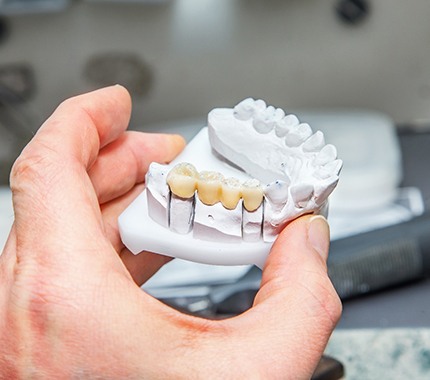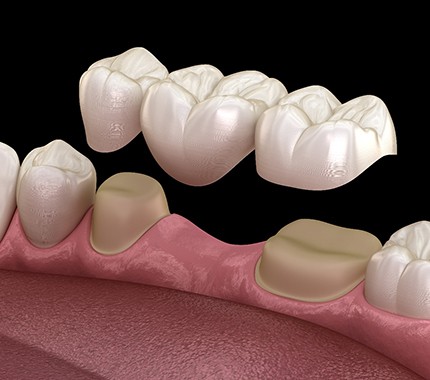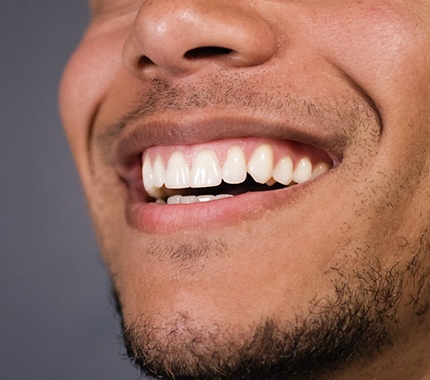 Infinity Dental Care
Infinity Dental Care
Dental Bridges – Hillsboro, OR
Show off a Complete Smile!
All teeth are responsible for performing many different tasks, including speaking, chewing, and keeping your smile aligned. If you’ve experienced tooth loss, you shouldn’t accept it! It is very important that you replace them to ensure the long-term functions of the tasks that you rely on. Dental bridges are one of the most common tooth replacement options in dentistry today thanks to their many benefits. To find out if a dental bridge is the best way for you to show off a complete smile, give us a call!
Why Choose Infinity Dental Care for Dental Bridges?
- Customized for Each Patient
- High-Quality Materials
- We Welcome Dental Insurance
What is a Dental Bridge?

Dental bridges work by “bridging” the gap where your tooth is missing. The bridge is supported by two dental crowns on each side of the gap. Bridges replace one or more consecutive teeth at a time and are not removable. This is because they are bonded into place, therefore offering a much more stable restoration compared to removable dentures. Bridges can only be removed by dental professionals.
Bridges offer a two-pronged solution to tooth loss. First, they improve your oral functionality. Second, they help you maintain your appearance. They work to support neighboring oral structures, such as the lips and cheeks, as losing a back tooth results in a sinking mouth and premature aging.
Dental bridges can be made from many dental materials, including metal alloys, gold, porcelain, or a combination of the three. In some cases, porcelain is bonded directly to gold or alloy.
Types of Dental Bridges

There are a couple of different types of dental bridges available to meet different needs. Here is how each of them works.
Traditional Dental Bridges
A traditional dental bridge is ideal for patients who still have healthy teeth on either side of the gap that needs to be filled in. The teeth that support the dental crowns are called “abutment teeth,” and they will be altered slightly so the bridge fits comfortably in the mouth. This type of restoration can be placed in just a few visits to the dental office and is generally the most affordable type of dental bridge.
Implant Bridges
If you don’t have any healthy adjacent teeth, surgically implanted metal posts, also known as dental implants, can provide an alternative. Dental implants can be used where there are three or more missing teeth in a row. Implant bridges last longer than traditional bridges on average, and they help to prevent bone loss over time as a result of tooth loss.
The Benefits of Getting a Dental Bridge

Dental bridges provide a variety of unique benefits. Here are some of the most prominent ones:
- Prevents dental drift
- Improves confidence
- Allows for thorough chewing
- Improves speech articulation
- Lowers risk of dental problems
- Cost-effective tooth replacement option
Dental Bridge FAQs

A dental bridge is the most traditional method to replace one or more missing teeth in a row. Although they are a tried-and-proven solution, it’s normal to have a few concerns before you’re ready to commit to one. Dr. Kalluri understands you have apprehensions, but there’s no reason to worry. Here are the most common dental bridges FAQs in North Dallas to calm your nerves.
Are there different types of bridges?
You have more options than ever to replace lost teeth using a bridge. After examining your mouth and learning more about your preferences, we’ll recommend which methods are right for you, such as:
- Traditional Fixed Bridge: All-ceramic material is used to recreate your teeth above the gum line. Bonding dental crowns to the adjacent teeth hold it in place.
- Cantilever Bridges: If you’re missing a tooth on one side, a cantilever bridge can be used because a single crown stabilizes the bridge.
- Maryland Bridge: A Maryland bridge doesn’t require dental crowns because it’s held in place by metal framework.
- Implant Bridge: 1-2 dental implants serve as tooth roots and anchor your bridge to your jawbone for a nearly perfect replica of your natural teeth.
We know it can be stressful determining which bridge is best for your smile, but we’ll help you make the best choice for your smile, budget, and quality of life.
How much does a dental bridge cost?
There’s not a flat rate for dental bridges because every smile is unique. Various factors affect their cost, such as if you need preparatory procedures, the number of teeth being replaced, and the type of bridge. We’ll provide you with a personalized estimate after Dr. Kalluri examines your mouth during your consultation . We don’t want your financial situation to prevent you from completing your smile, which is why we offer several payment options. Besides traditional payment methods, we also accept third-party financing to pay for your bridge in installments.
Can I use my dental insurance to pay for a bridge?
Every dental insurance plan differs, but most offer coverage for dental bridges. Although it may not cover the entire cost, it can offset the amount you pay out-of-pocket. After reaching your annual deductible, your insurance can pay up to 80% of the bill until hitting your yearly limit. We know dental policies are confusing, but you don’t have to navigate your insurance on your own. A member of our team will work on your behalf to file the required claim forms. We will maximize your dental benefits to lower the amount you’ll pay to keep a beautiful smile within your budget.
How long will my dental bridge last?
Several factors affect the lifespan of your bridge. Traditional bridges last for about 5 to 10 years before needing to be replaced, while implant methods can last for a lifetime. You can ensure your new teeth last for decades by committing to your oral hygiene and visiting your dentist regularly for a cleaning and checkup. It’s best to avoid anything that can damage your bridge, like using your teeth as tools.